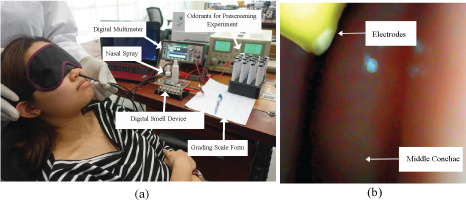Electrical stimulation, Virtual olfactory perceptions, Olfactory measurements.
THE human nose is a complicated and smart part of the chemosensory system. Humans have multifaceted olfactory bulbs and orbitofrontal cortices, which provide them with more sensitive and dynamic abilities for the sense of smell [1], and as such humans could detect at least 1 trillion different smells [2]. In the olfactory epithelium, odour molecules bind to olfactory receptors which are expressed in olfactory sensory neurons in the nose [3]. Once an odorant binds to the receptor, the olfactory receptors trigger a series of signals to the cells interiors that ultimately results in the opening and closing of ion channels. The opening of the ion channels increases the concentration of positive ions inside olfactory cells. This depolarization causes the olfactory cells to release tiny packets of chemical signals called neurotransmitters, which initiate a nerve impulse. Odour information is then relayed to many regions throughout the brain [4] which is perceived as smell.
Electrical stimulation can create depolarization in the nerve cells, which can then induce action potentials with sufficient depolarization magnitude [5]. It can be argued that electrical stimulation of the olfactory receptors may reproduce smell sensations, as electric stimulation produces taste sensations [6] in a practice known as electrogustometry [7].
The main objective of this research is to investigate the sensations produced by electrical stimulation in the nasal cavity. Therefore, we developed a electrical stimulator circuit that can produce weak electric pulses of various frequencies and currents [8]. This device can generate square wave patterns of constant current (1 mA - 5 mA) with different frequencies (0 Hz - 30 kHz) and pulse width. Using a pair of small silver electrodes and an endoscopic camera, we stimulated human participants as in Figure 1. Our stimulations were majorly at the middle concha where olfactory local field potentials are easily acquired [9], while few were at the superior and inferior conchae, based on the results from epithelial biopsies on spread of olfactory mucosa [10,11]. The stimulation rate used in this experiment were randomized between 2, 10, 70 and 180 Hz, however, current applied for the stimulation is increased gradually starting from 1 mA till 5 mA. The stimulation duration was kept at 10 seconds with stimulation interval for 60 seconds and each participants underwent 8 trials which lasted for 45 minutes.
We measured the induced sensations using a measurement index that can record intensities of 22 different sensations. The sensations were divided into two categories: The first category consisted of the 10 basic smells (fragrant, fruity, citrus, chemical, sweet, minty, Toasted/nutty, decay, and pungent) as characterize by [12]. The second category consisted of 12 induced non-olfactory sensations (cooling, heating, electric, pinprick, tingling, numbness, metallic, burning, pleasant, pain, lingering, and pressure). About 1/4th of the participants reported perception of different types of smell sensation such as fragrant, minty, sweet, and chemical smells for stimulations at 1 mA/70 Hz and 1 mA/10 Hz [8]. This result suggests that there could be an electrical path to generate smell sensation in human using electrical stimulation. In medical field, we hope electrical stimulation will be useful in treating patients who are suffering from medical conditions such as anosmia and parosmia.

Figure 1: a) Electrically stimulating the middle and superior conchae regions of a participant using the laboratory built electrical simulator; b) View from the endoscopic camera while stimulating middle nasal conchae using silver electrodes.